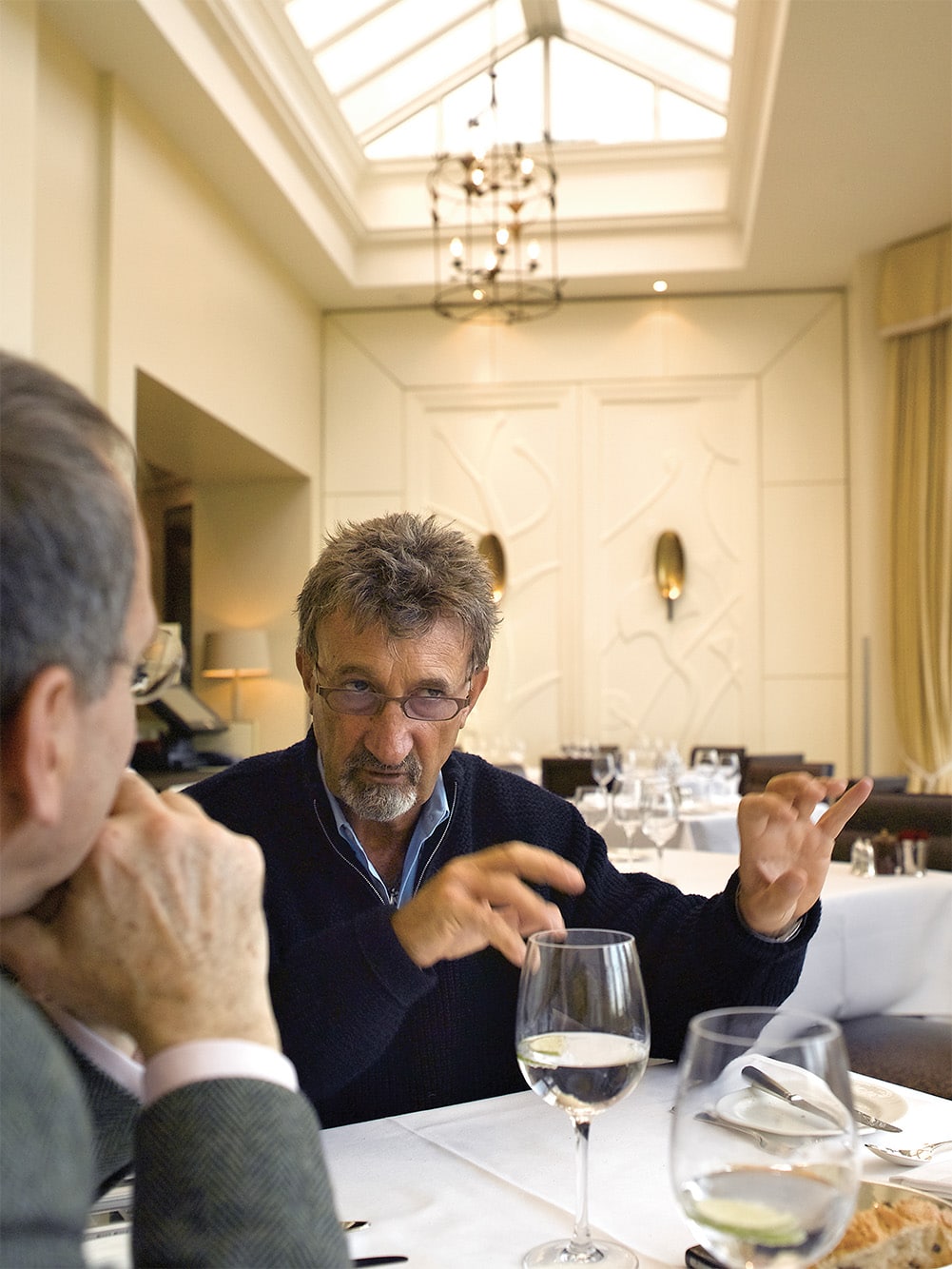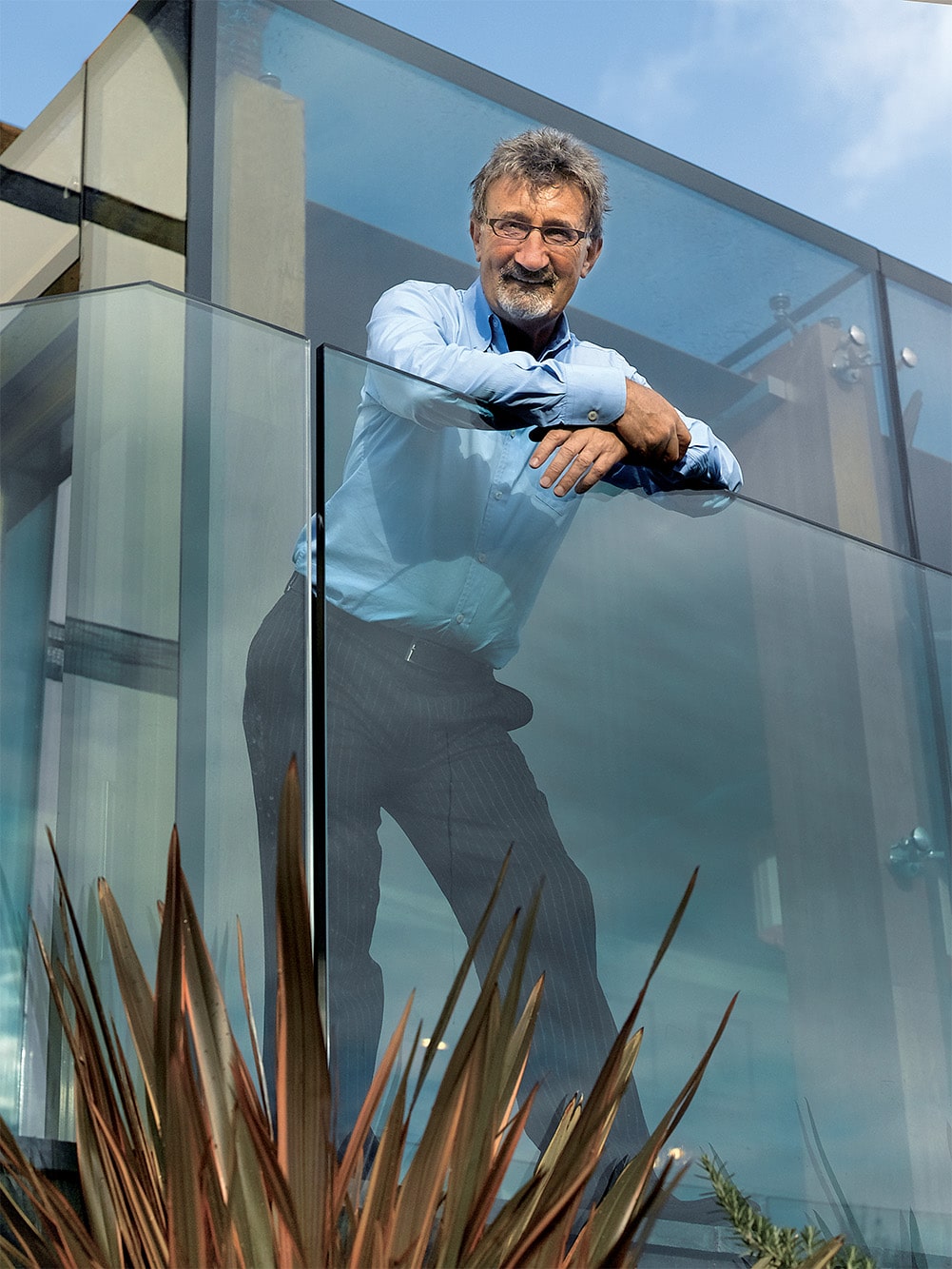Lunch with Eddie Jordan
He’s the racer-turned-team boss whose wheeling and dealing helped him scale the heights of Formula 1 – and bring a sense of fun to the grid

James Mitchell
It’s safe to assume that we will never again see the like of Jordan Grand Prix. As the financial and political qualifications for entry into Formula 1 become ever tougher, and the paddock becomes more and more serious and straight-faced, so the possibility of another team like that recedes further.
Jordan burst upon F1 in 1991, constantly punching above its weight and always teetering on the edge of financial disaster. The green, then red and blue, then gold, then yellow cars graced the grids for 14 seasons, until Eddie Jordan bowed to the inevitable and sold the team to Midland. It lives on in today’s Force India outfit, and EJ himself is back in the paddock this year as part of BBC TV’s new coverage. But the buccaneering irreverence that he and his team brought to F1 is no more.
“We were johnnie-come-latelys, noisy, brash, having a good time, giving the establishment two fingers. So we got lots of attention, lots of value for our sponsors, and a huge fan base. We always measured our popularity by how much we could sell to the public – from stickers and clothing to subscriptions for our own team magazine. By the late ’90s our merchandising revenues were virtually on a par with Ferrari, and streets ahead of McLaren. It was down to the bright yellow livery, the Hissing Sid [the snake painted on the car’s nose], the Page 3 girls draped over the cars, all that rock ’n roll. But we did the job, too. We won races.
“You have to remember that, in the last 20 years, only four other teams – Ferrari, McLaren, Williams and Renault/Benetton – have scored more than a single win. In our best season we were third in the Constructors’ Championship, and third in the Drivers’ Championship. Other teams had more speed, more technology and much, much more money. So our strategy in any given situation was to think what Ferrari and McLaren would do, and then do something different. We’d gamble on the unexpected – the weather, an accident, a pace car – or we’d take a big risk on fuel strategy or tyre wear. Always second-guessing.
“We ran new drivers because they were cheap, or because they paid. And we hired young, untried team personnel. We were a university for F1. I look around F1 today with a certain amount of pride, because so many top men started at Jordan: Rob Smedley at Ferrari, Sam Michael at Williams, it’s quite a list. They made their mistakes with us and learned from them, and we encouraged everyone to chip in with any idea, however off-the-wall. You’d be amazed how many good ideas came up.
“I ran Jordan on a shoestring. My law in the factory was, ‘No money can be spent unless it makes the car go quicker. If it doesn’t make the car go quicker, don’t ask for it.’ We always had deals on motorhomes, deals on trucks, deals on catering, deals on everything. We used second-hand brakes that McLaren had returned to the manufacturers. We’d have them reskimmed, and they were fine. We’d use reconditioned clutches. Formula 1 today is scandalously wasteful. It’s a pissing contest, seeing who can piss away the most money. If I’d been born 15 years later, I would never have got into F1. On my budget, you couldn’t buy postage stamps for a team now.”
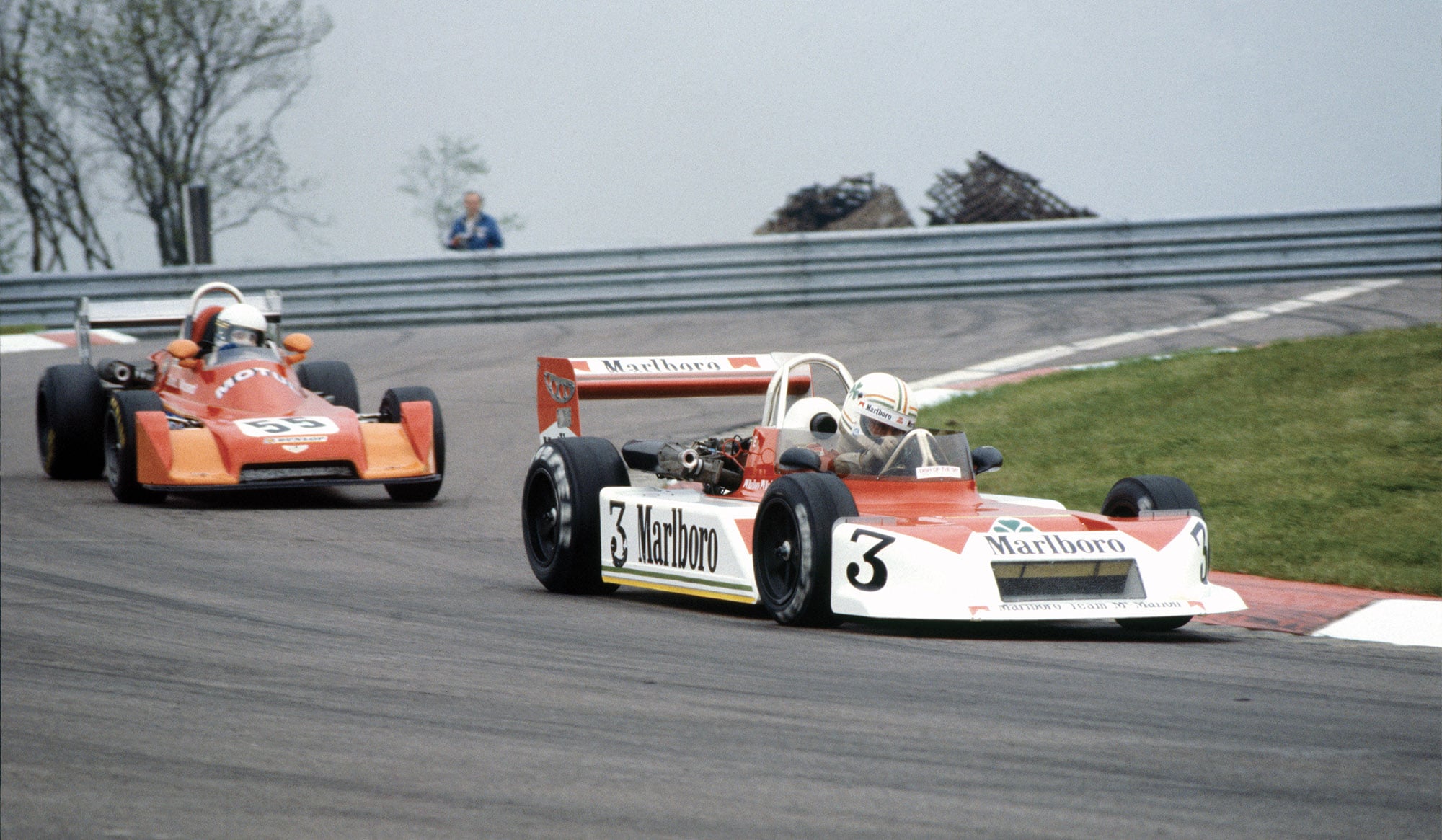
EJ, the F3 racer, at Donington in 1979
Motorsport Images
Yet F1, in the end, made Eddie a rich man. He and Marie, his wife of 30 years, now live in a palatial house in the private estate adjoining the famous Wentworth golf course in Surrey. When we meet for lunch in the clubhouse, he’s just back from a tournament in Barbados and is rehearsing in his private recording studio with his current rock band, Eddie & The Robbers, who’ve been booked for three days of gigs in his homeland. Then they’re off to Australia, for Eddie to make his F1 TV debut but also for the band to support The Who at the post-Grand Prix bash – like those great Silverstone parties when Eddie’s Pitstop Boogie Boys would perform after the race.
From humble beginnings in Dublin, developing a love for girls and Guinness and rock music, Eddie found gainful employment when his aunt, a nun, got him a job in the Irish Sisters of Charity Bank. School learning was not his strong suit, but he had a talent for doing mental arithmetic at lightning speed, which went with a taste for wheeling and dealing that had started in the playground with conkers, marbles and even school textbooks. When a customer came into the bank asking for a loan to buy a car, Eddie would casually ask what sort of car was wanted. Then he’d feign surprise, saying his best friend was selling his own car just like that, an immaculate example. He would then hastily source a car from one of his trader mates, beat him down to a price and sell it next day – at a suitable mark-up – to the delighted bank customer.
In 1970 there was a bank strike in Ireland so, unable to earn, Eddie got himself to Jersey where he worked as a clerk for the Electricity Board by day and a barman by night. While there he went to a seaside kart track, tried his hand and became hooked. Back in Ireland he wangled the means to buy a kart and go racing, winning the Irish Kart Championship in 1971. Then he bought, for £450, an old Formula Ford Lotus. A Crosslé 20F followed, and Eddie began to compete seriously across Ireland, with occasional forays to England.
He set about Formula Ford just as he would set about Formula 1 20 years later: ducking and diving. Money was impossibly short, of course, but Eddie could always squeeze a quart out of a pint glass. He persuaded a Dublin carpet shop to sponsor him – but the sponsorship took the form of Eddie painting the shop’s name on the side of the car, and receiving carpet remnants in payment. On Saturdays when he wasn’t racing he’d set up a stall on Dublin’s Dandelion Green and flog his carpets. “I loved it – the banter, the bartering, the blarney.”
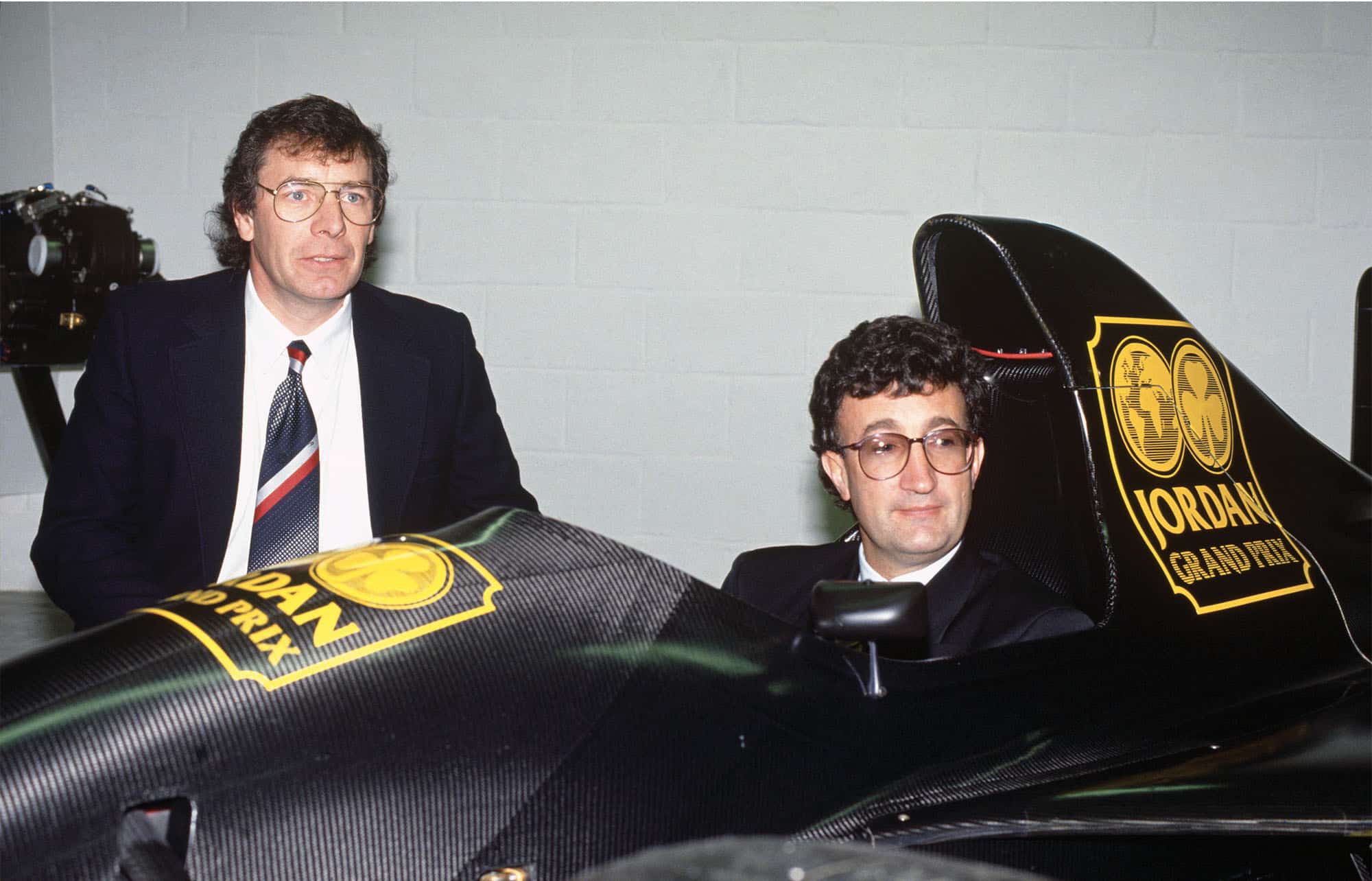
Launch of first F1 car, alongside Gary Anderson
Motorsport Images
Despite a big accident at Mallory Park in 1975, when he broke both his legs, Eddie graduated to Formula Atlantic under the proud banner of Marlboro Team Ireland, which showed that his ability to drum up sponsorship was developing faster than his prowess in the cockpit. Having won the 1978 Irish Championship, he decided to move to England and tackle Formula 3 – at the age of 31. He found a squalid little house in Silverstone village for £3000, and furnished it with house-clearance stuff. He got the fridge for 50p. The long-suffering Marie got a job packing for a food company at £1.25 an hour, while Eddie lodged a planning application for the derelict garage at the bottom of the garden – and sold the house for £10,500 profit. This bought a five-bedroom house nearby so he and Marie could take in lodgers. For the British GP weekend he managed to cram in 17 paying guests.
After various F3 adventures, a few races in a Porsche 908 and a ride in Steve O’Rourke’s BMW M1 at Le Mans, Eddie decided that his future lay not in driving cars but in doing deals. For the 1981 season he bought a Ralt F3, and Eddie Jordan Racing was born. Several promising hopefuls drove for him, when they came up with the requisite money: David Sears, David Leslie, James Weaver, Tommy Byrne and one Wyatt Stanley, who agreed to pay £1700 for a race at Dijon. Stanley ran a string of bingo halls in the Midlands, and arrived with 17,000 10p pieces in sacks. It was all money to Eddie.
In 1983 came the historic battle in the British F3 Championship between Martin Brundle, in the EJR car, and Ayrton Senna, driving for West Surrey Racing. “That season cost £65,000. Martin’s dad put in £15k, and I persuaded the BRDC to put in £20k. I even got four grand out of Tom Walkinshaw. Various people I knew put in a bit, and we got our money back by managing Martin as he moved up the ladder. We so nearly won the championship because we psyched Senna, and he started to make mistakes. By rights he should have walked it, but it went down to the wire. It was a difficult year because our transporter went off the road coming back from a race in Austria, and our chief mechanic Rob Bowden was killed. That was devastating.”
EJR did win the F3 championship in 1987, with Johnny Herbert, and in 1988 there was a two-car team in F3000. “For the first round in Spain the cars were virgin white, not a sponsor on them, and Johnny put it on pole. Camel were with Lotus in F1 then, but I’d heard they weren’t happy. So I got Camel boss Duncan Lee on the phone that evening and said I’d put Camel stickers on the cars for free the next day, if he agreed to meet me the following week. Johnny won the race, and a few days later we got Camel sponsorship for both cars.” At Brands in August Herbert had his dreadful accident, but still managed a remarkable F1 debut for Benetton seven months later. And for 1989 Eddie ran Jean Alesi in F3000.
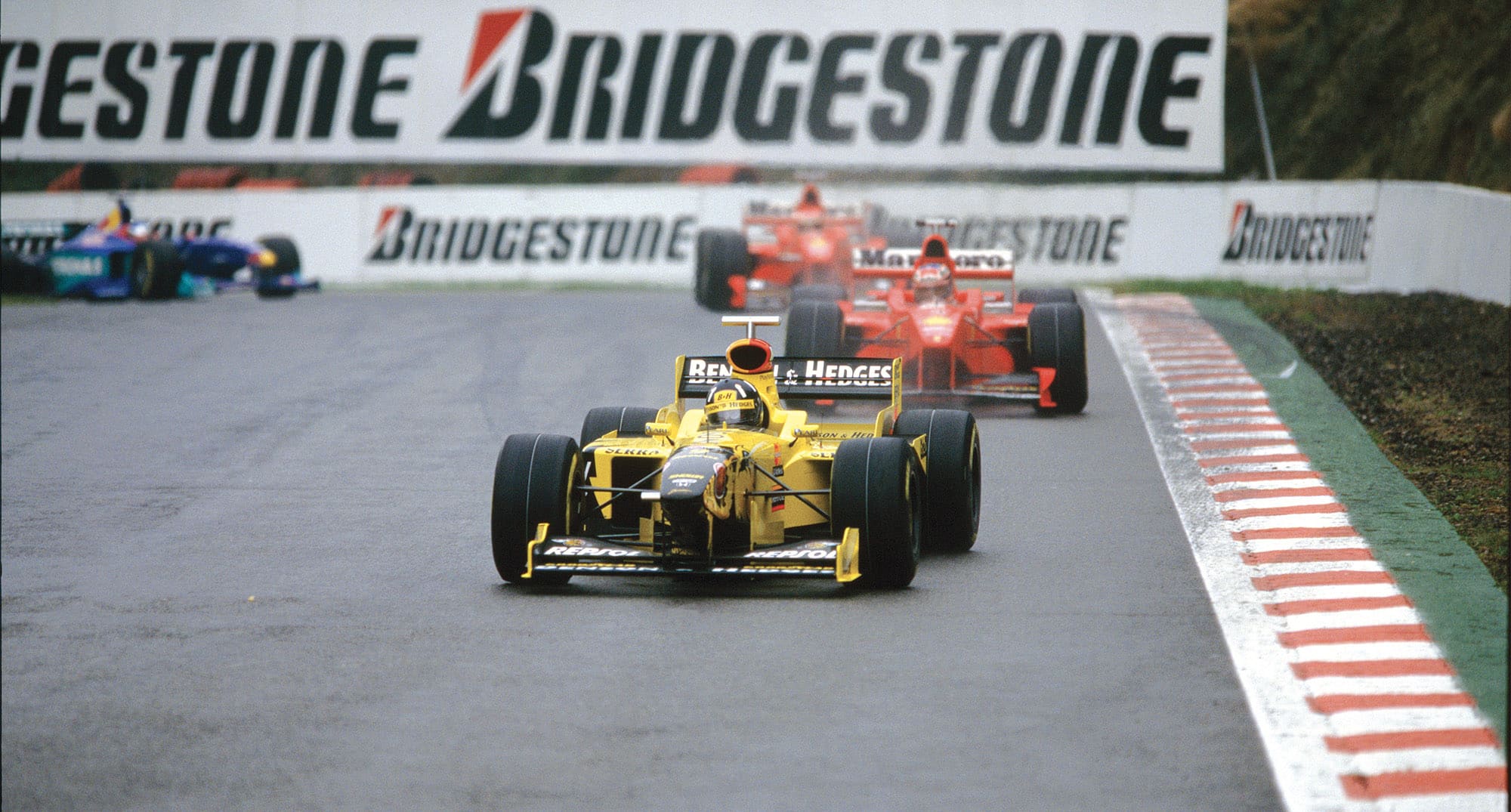
Damon Hill leads the Ferraris en route to Spa victory in 1998
Motorsport Images
“Jean was pretty much washed up. He had a reputation for being a prima donna, and he’d fallen out with [French F3000 team] ORECA, but I told him to get his arse over to England, learn our language, learn how to treat his mechanics, and stop crashing. He had nowhere to live, so he moved in with Marie, me and the kids. The Birmingham street race was on August Monday, the day after the Belgian GP. Camel had a lot of guests at Spa, but both Lotuses failed to qualify. So they flew them all over to Birmingham, and watched Jean win. He won at Pau and Spa as well, and took the F3000 title.
“What was even better was Jean’s F1 debut at the French GP. Tyrrell driver Michele Alboreto had to stand down with a contractual problem, and I told Camel Jean should do the race for Tyrrell. I had his contract, of course, so I negotiated a fee with Bob Tyrrell, which wasn’t easy. In the end we settled on about eight grand, I think. But Bob said nothing about subsequent races, which I thought was strange. Maybe he didn’t think Jean was going to be any good. But you should always cater for the future, just in case the guy turns out to be good, so you don’t have to go back with your pants down and be raped if you want to keep him. So first practice, Friday morning, Jean has never sat in an F1 car before, and he’s seventh fastest. In the race he’s sensational: comes through the field, holds second place before his stop for tyres, finishes fourth. In a Tyrrell! Next morning Bob’s in my office: ‘Right, we want you to release him for the season.’ He really had to pay for that – and when the GPs clashed with F3000 rounds, Jean still drove for me.
“About now I started to think about going into F1. We’d won a lot of F3000 races, and Brundle, who was at Brabham by then, and Herbert at Benetton, and especially Alesi, they told me that F1 wasn’t all that different. I’d made a bit of money by now, had about £5 million in the bank. I could have stayed doing what I was doing and made the next £5 million. But I talked to Marie about it, and she said, ‘You’ll never be happy until you do it. Let’s get on with it. If we lose everything we’ll only go back to where we were at the beginning, so it can’t be worse than that.’”
So Eddie rented another lock-up at Silverstone and gathered his team around him: team manager Trevor Foster, business aide Ian Phillips, designer/engineer Gary Anderson. Ian, former journalist and circuit manager, was a shrewd sponsorship hunter who knew exactly how Eddie’s mind worked. “Ian was a jewel in our crown. He’s hideously bright, with a brilliant memory, and he’s the world’s greatest survivor. Also he knows how to party. He’s Force India’s commercial director today.” Anderson is a Northern Irishman who’d worked in F1 for Brabham and also produced his own F3 car, the Anson. He joined Eddie from Reynard during the F3000 days. “Gary was the biggest possible factor in Jordan’s entry into F1. The man’s a genius. He didn’t believe in himself enough to realise how good he was. We’d have heated discussions – two Irishmen in one room, one big, one small – but we always emerged without any blood on the carpet.”

F1 rookie Michael Schumacher at Spa in 1991
Motorsport Images
Eddie did a deal with Cosworth for customer engines, and persuaded Goodyear to supply tyres, when most of the tiddler teams had to go with Pirellis. His hopes of getting his F3000 sponsor, Camel, to come on board were scuppered when Ford persuaded it to go with Benetton, so Eddie went after Marlboro. That produced $3.5 million plus one of the drivers, in the shape of Andrea de Cesaris. De Cesaris has been much sneered at by the pundits, but Eddie awards him high praise. “He became a different person with us. He was a pain in the arse, of course, a real baby, but he was quick, and he was funny.” Eddie talked up further backing from Fuji, drinks company 7UP and, amazingly, the Irish government. The other seat went to Belgian Bertrand Gachot – until his altercation with a London taxi driver sent him to Brixton Prison, leaving his seat vacant mid-season.
With 34 entries for the 26 places on the F1 grid, five teams – Lamborghini, Coloni, Fond-metal, Dallara and Jordan – had to do battle early on Friday morning to weed out the four slowest, who would not even get the chance to try to qualify. “I’ve never been ill, except with the worry of pre-qualifying. There was so much at stake, it gave me piles. But – apart from Andrea’s car in our first race at Phoenix, when he buzzed the engine – we always got through. By halfway through the first year, when they revisited the list, we’d already scored points in four races, so we were in the clear.” Anderson’s first F1 car, the Jordan 191, was neat, elegant and effective. Good finishes started to come, and the little team finished a brilliant rookie fifth in the Constructors’ Championship, ahead of the likes of Tyrrell, Lotus and Brabham.
But that September Eddie had a dramatic introduction to the ruthlessness of F1.
“With Gachot banged up, I needed a replacement. There was a sports car racer for Mercedes called Michael Schumacher. I knew next to nothing about him, but his management were pushing him at me very hard, so I agreed to run him at Spa. I charged them £150,000.” The German rookie qualified a sensational seventh and, although his race lasted only a few yards, at once he was the man everyone was talking about. Few remember that de Cesaris was lying second in that race with three laps to go, catching leader Senna who had a gearbox problem, when his engine quit.
At Spa a letter of intent covering the rest of the season had been signed by Schumacher’s management, but they slipped in a weasel. The words “we will sign the contract” were changed to “we will sign a contract”. A week later Schumacher did indeed sign a contract, but it was with Benetton. Jordan advised Roberto Moreno, who was losing his drive to accommodate Schumacher, to take out an injunction against Benetton. Moreno did this in Milan on the Thursday of the Italian Grand Prix, but in an all-night meeting in the Villa D’Este involving Bernie, Flavio Briatore and a very reluctant Eddie, Moreno was offered $500,000 to withdraw the injunction. At 2.30am he weakened and took the money, and Eddie’s position collapsed. So he promptly signed Moreno to do the next two races, thus relieving the Brazilian of most of his buy-off…

Eddie mans the drums at a British GP party
Motorsport Images
But Eddie’s £5 million in the bank was now a £5 million overdraft. After one season, the F1 game seemed to be over when Cosworth placed a winding-up order against Jordan for non-payment of bills. In the High Court the irrepressible Eddie talked the judge round, pointing out that Cosworth was charging him £121,000 for an engine rebuild when a new engine cost only £110,000. The winding-up order failed. “We still had to pay most of it in the end, and that’s how a Jordan 191 ended up in a German museum. Schumacher actually drove two Jordans over that Spa weekend. I still own one, and it’s in the Donington museum now. We gave the other to Cosworth in part-payment for our debt – we told them the first F1 car Michael Schumacher ever drove was worth a big sum of money – and when VW bought Cosworth it ended up with them.”
Eddie used V12 Yamaha engines in 1992 and had a very thin year, and then switched to the V10 Hart. Sasol, a South African oil company, was now the title sponsor. At Aida in 1994 Rubens Barrichello scored Jordan’s first podium. But at the next race, Imola, he had a giant accident in Friday practice. Although his injuries were miraculously slight, it was the start of a black weekend which cost the lives of Roland Ratzenberger and Ayrton Senna.
“That whole weekend was a nightmare. I can still remember the Sunday evening flight home with all the F1 circus on board. Those flights are usually pretty noisy, but nobody said a word, nobody ate or drank. It was totally sombre, the most eerie flight I’ve ever been on.
“After being wary of me during the F3 period, Ayrton had become quite friendly. And during 1993 I had this amazing idea. Ayrton was coming to the end of his time at McLaren, he wasn’t seeing eye to eye with Ron any more. So I went to Ayrton and offered to give him 49 per cent of the team. For nothing. I reasoned that my 51 per cent of a team which had Ayrton on board would be worth more than 100 per cent of a team without him. He’d be able to pull the team around him, concentrate on his ambitions, and with him we could raise the backing to put Jordan on a different level. Honda would have come with him for sure. I told him he didn’t even have to drive for us until we were ready to give him what he wanted. Some may think it mad to give away half my company, but to me it was a no-brainer. Ayrton took my proposal very seriously. I went to his island beach house at Angra, and we went through it. I don’t know what might have happened if he’d lived.”
High spot of 1995, now with a works Peugeot engine deal, was Canada, when the Jordans of Barrichello and Eddie Irvine finished second and third – behind old friend Jean Alesi, scoring his one and only victory for Ferrari. “Afterwards Jean said to me: ‘Today it was a Jordan 1-2-3.’ Have you noticed how many Jordan boys drove for Ferrari down the years? Johansson, Alesi, Irvine, Barrichello. People ask who has been my biggest sponsor during my career: I tell them, Ferrari.

Heinz-Harald Frentzen on the limit. In 1999 he became Jordan’s most successful driver, with six podiums and two wins
Motorsport Images
“For 1996 I had Irvine under contract, paying him next to nothing, telling him how lucky he was to be in an F1 car. But I knew he was ready to move on. So I called Schumacher, who was just going to Ferrari from Benetton, and suggested Irvine was the team-mate for him. I said Eddie wasn’t lazy, he’d do all the testing they wanted, he wouldn’t expect to win because he knew that would be Michael’s role. Michael talked to [team director] Jean Todt, Todt talked to me and then had a meeting with Irvine, and I spoke to John Hogan and Graham Bogle at Marlboro, because I knew they actually paid the Ferrari drivers’ wages. Then Eddie and I went to Switzerland, and I had a meeting with Henri Peter, Ferrari’s lawyer. He got Luca di Montezemolo on the phone to tell me the payment I was demanding to release Irvine from his Jordan contract was way too much, and that I didn’t understand the drivers’ market or the way of the world. When Luca rang off I reminded the meeting that Eddie had an offer from Ligier [Gitanes, Ligier’s sponsor, were sworn rivals of Marlboro] and how much it was going to cost me to replace a driver of Eddie’s calibre. I left the room with a great deal for Irvine, with a bonus linked to the team’s overall performance rather than just his own results, so that when Schumacher did well, he’d do well. There was also $5 million for me for selling out his contract with my team. Eddie had wandered off, but eventually I found him beside Lake Lugano, feeding the ducks.
“Eddie is a very bright boy. He says all the things he missed at school he learned from me. I didn’t tell him what Ferrari were paying me to release him, but when I told him the meeting had gone well he looked me in the eye and said, ‘I’ve changed my mind. I love driving for Jordan, they’re like family to me. I think I’ll stay.’ He knew that was the last thing I wanted – in my mind I’d already spent my cut. In the end I had to give him $1 million of my $5 million to f*** off to Ferrari.
“At that moment my phone rang. It was Bernie Ecclestone. Bernie is unbelievably astute, and he knows everything that’s going on in F1 almost before it happens. ‘Where are you, Jordan?’ ‘I’m standing by a lake, feeding the ducks.’ ‘I didn’t say what are you doing, I said where are you. I hear you just put Irvine with Ferrari. Thanks for telling me.’ ‘Bernie, you were going to be my next call…’”
For 1996 a new sponsor, Benson & Hedges, came on board. Eddie had been chasing them for five years. Martin Brundle returned 13 years after his F3 title, and put the team on the front pages with his lap one accident in Australia. The gold livery looked good, but didn’t show up the logos so well on TV, so it was switched to the vivid yellow which quickly became the team’s trademark. In 1997 new team-mates Ralf Schumacher and Giancarlo Fisichella drove into one another on more than one occasion, but Fisichella was second at Spa, and led Hockenheim before being delayed by a puncture. But it wasn’t until 1998 that Jordan was able to pull itself up from its traditional best-of-the-rest position behind the Big Four.
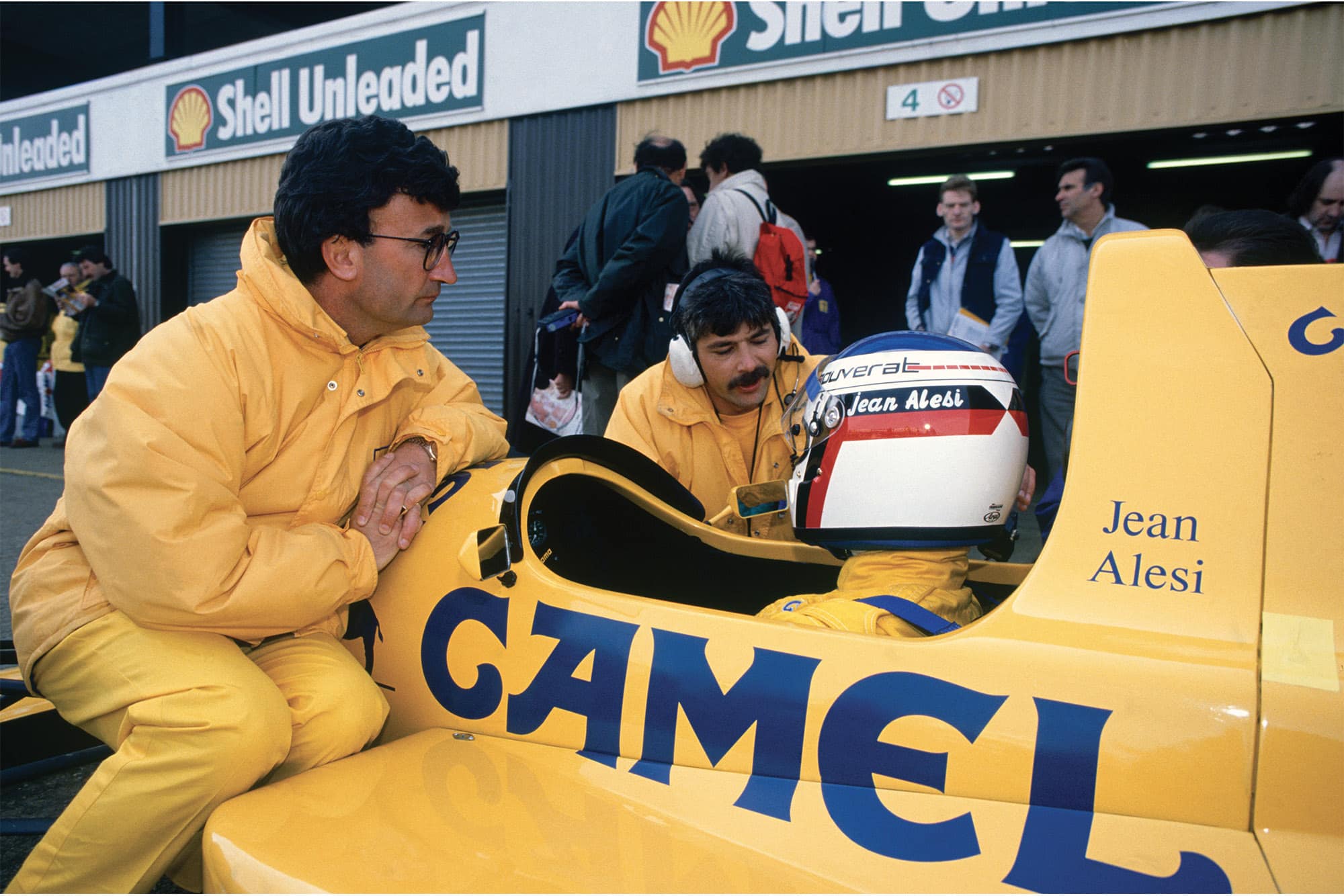
Eddie won the 1989 F3000 championship with Jean Alesi
Motorsport Images
Now Eddie had an ex-World Champion, Damon Hill, driving and Mugen-Honda supplying engines. The season started badly, with Damon saying the car wasn’t good enough, and some people in the team saying Damon wasn’t good enough. But gradually the car improved, and at Spa Damon scored Jordan’s first F1 victory, with Ralf Schumacher second. That magic one-two propelled Jordan to fourth in the Constructors’ Championship.
For 1999, Heinz-Harald Frentzen replaced Ralf and had a brilliant season. He won two Grands Prix, at Magny-Cours – with a very clever fuel strategy from the pitwall – and, on sheer speed, at Monza. Only an unlucky electronics glitch prevented him from winning at the Nürburgring, too. He finished third in the Drivers’ Championship, and Jordan was third in the Constructors’ behind Ferrari and McLaren. It was the team’s best year, but financially Eddie was still right on the edge.
“Bernie always supported me, and there were times when he lent me the funds to get over a particularly difficult time. Did he charge me interest? Of course he charged me interest… But in 1997 he said – he always speaks to me like this: ‘Jordan, I’m tired of bumming you up, fronting you the dough. You’re going to go skint. You’ll have a raspberry [South London car dealers’ slang for a heart attack], then you’ll be brown bread, and I don’t care shit about you, but what about your wife and kids? You need to hook up a monkey quick, and nick a few quid out of him.’
“Then I met a man at a football game who was acting for a big equity firm in New York. He was looking at buying Everton. I said, ‘Nothing wrong with Everton, but I can see you’re a man of the world. Let me tell you, you’re going to get much more business potential out of a Formula 1 team.’ I ended up selling 49 per cent of the team to Warburg Pincus. They also bought 49 per cent of the debt. A couple of years later that man left the firm, and they started to get a bit jumpy in New York. So I bought it back. I won’t tell you the figures, but it was a very good deal for me.
“During 2001 I had to get rid of Heinz-Harald to make way for Takuma Sato, to be sure of keeping Honda when there was pressure on them in Japan to put all their efforts behind BAR. That gave me a rough ride from the German fans at Hockenheim, but in 2002 we still scored more points than BAR. Then Honda told me they couldn’t supply us with engines for 2003. They behaved impeccably – they paid $22 million to terminate the contract one year early, to help us pay for our engines in 2003 – but that left us back with Cosworth.”
In fact, Eddie nearly did a deal with Mercedes to run customer engines for 2004. The cars would have been entered as Jordan-Smarts, and the idea was to market a sporty version of the little road car called the Smart Jordan. To Eddie’s fury, Ford blocked this – before announcing its own withdrawal in September 2004. He immediately did a deal to secure Toyota engines for 2005.
Jordan’s final victory came in Brazil in 2003, when – helped once again by clever fuel strategy – Fisichella snatched victory at the very end of a dramatic wet race. Because of a timing confusion, at first the win was given to Kimi Räikkonen’s McLaren, and it was only awarded to Giancarlo some days later, after Eddie successfully protested. Meanwhile F1’s costs continued to escalate. “I’d started the team on 18 people. Just a few years later, I had 265. You don’t feel in control by then. The costs had become obscene. It was costing half a million a month to keep the team going, and it was eating into everything we had. I could see the results weren’t likely to get any better. As maybe the last of the true independents, I knew the threat of ruin would hang over me and my family as long as I was in F1. Bernie said to me, ‘Jordan, that’s it. You should get out. If you won’t find a buyer, I will.’ Then he summoned me to Prince’s Gate and introduced me to a Russian-born Canadian billionaire called Alex Schnaider. By January 2005 the deal was done, and I was out of Formula 1.”
Since then Eddie has thrown his entrepreneurial energies into all sorts of activities, from investment companies to energy drinks, and charities like CLIC [Cancer & Leukaemia in Childhood] and the Amber Foundation for homeless young people. “I’ve moved on. I’ve finally got the motor racing needle out of my arm. And now I’m looking forward to being back, but on the other side of the fence, for TV.
“I loved my time in F1. It wasn’t work for me; it was a playground. Ron Dennis said to me once, ‘It’s just as well you never got serious.’ But Formula 1 changes people, and not always for the better. They think they are more important than they are, they have big delusions of grandeur about their worth. You could refloat the Titanic on the egos in F1. Maybe
I was starting to get a bit like that, too. That little group secure in the paddock, everybody outside clamouring to get in, even the great and the good can’t get a pass unless we give them one. You start to think, I’m pretty cool. But it’s all crap, really. My feet are back on the ground now.”
Which means that Eddie’s TV take on the pool of piranhas that is today’s F1 will be a breath of fresh air. It should make for good viewing. But it won’t stop us wishing that the irreverent team with the yellow cars and the fast-talking, blasphemous Dubliner at its helm was still on the grid.
